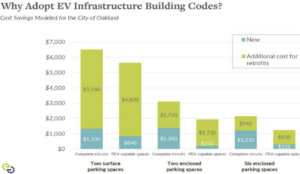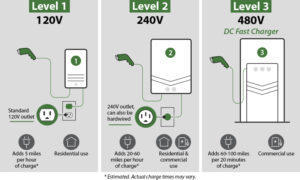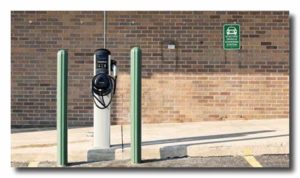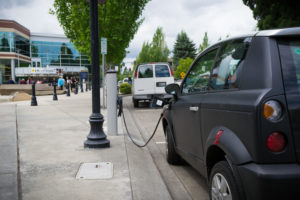Description
Municipalities should require electric charging capability at residences. This will lower the barrier to owning an electric vehicle (EV) and encourage a faster transition to EV ownership. Currently, 80% of all EV’s are charged at home but EV charging does not exist at the majority of residential and multi-family properties and retrofitting existing properties is more expensive than incorporating EV readiness into the initial design and construction. “Installing EV capable parking spaces in stand-alone retrofits is typically 4 to 6 times more expensive compared to installing EV capable parking spaces during new construction. If EV capable parking spaces are installed during new construction, $2,040 – $4,635 per parking space is saved over the retrofit scenario.”
Why Adopt EV Infrastructure Building Codes?

Municipalities need to be forward thinking to meet demand. According to the International Energy Agency, electric vehicles currently make up more than 2% of global car sales. That is expected to increase to 58% by 2040. States are beginning to discuss phasing out fossil fuel vehicles. In April of 2021, Washington State proposed a bill that aims to mandate that all new light-duty vehicles sold and registered by 2030 be electric with few exceptions for some vehicles such as emergency vehicles. Enacting EV readiness or installation of chargers in new construction anticipates a future time when all residents will own EVs and will require charging capability. Currently more than 30 local jurisdictions across the United States require at least one EV-ready parking space. The charger can be in the garage, accessible from outside the house, or both.


1
2
3
Implementation Phases
Require EV charging at new buildings.
Require EV charging when renovations are performed.
Require EV charging at all buildings.
Challenges
Electric chargers require 40 or 50 amp circuits which could challenge homeowners who have maxed out their open circuit slots in their electric service panel, requiring a sub panel to be installed.
Educating building inspectors and code officials.
Educating builders, architects, and owners about benefits.
Example Municipalities
Several municipalities have already implemented this action…
- Atlanta, Georgia’s ordinance 17-O-1654 can serve as a model for municipalities in the Capital Region. Within the ordinance, Atlanta details its regulations building local EV infrastructure including requiring residential structures and a 1:5 ratio of EV charging stations per parking space throughout the city
Greenhouse Gas (GHG) Reductions
Data
Average new residential building construction per year: 65 [Town of Bethlehem Demographic and Growth Analysis 1991-2018, p.9]
Average number of miles per car per in NY : 11,871 miles [What is Average Mileage Per Year?, New York state ]
GHG emission reduction when switching from gas car to EV : 50% [Electric Vehicles, Emissions and Fuel Economy]
Assumptions
Every new residential unit has 2 cars.
Methodology
We calculated the:
- Total number of cars each year in new constructed residential units.
- Total CO2e per year by the average emissions by using conventional cars by all new households.
- Total emission reduction when new households shift from gas to electric cars.
Result
310 metric tons of CO2e is reduced per year by switching from gas to electric cars by all the newly constructed houses with electric vehicle charging capability.
This results in MODERATE GHG emissions reductions.

Climate Smart Communities (CSC) & Clean Energy Communities (CEC) Link
This action is also related to CEC and CSC actions for which municipalities can earn points toward certification. The NYStretch building code includes a requirement for EV charging readiness. Municipalities that adopt the NYStretch building code can:
CEC Actions:
- Access 1200 CEC points and also action grants up to $50k through CEC’s NYStretch Energy Code Action. After completing this CEC action, municipalities can also:
CSC Actions:
- Earn 10 CSC points through CSC’s PE6 Action: NYStretch Energy Code.

Co-benefits
There are multiple co-benefits to completing this action, including:
- Accelerated transition to electric vehicles.
- Reduced costs of adding chargers during construction vs. adding later which may require new circuit breaker boxes.
Resources
The U.S. Department of Energy details charging vehicles in residential homes.
Chargepoint compares the different electric charging stations one can install in their home.
Green transportation published Understanding kiloWatt-hours in electric cars and other gizmos.
AutoGuide and Energy Sage compare The Best Home EV Chargers
The cost to install the 240 volt circuit varies and depends on the distance between the electric service panel and the charger location. As of 2021, Federal tax credits exist to reduce federal income tax liability when installing an electric car charger. Electric chargers cost between $500 to $700 before incentives are applied.
Language to consider in municipal ordinance:
Municipalities should require:
- EV-Ready construction should require raceways, adequate space in the electrical panel, and sufficient space within the electrical equipment room to accommodate future additional electrical capacity to install Electric Vehicle Supply Equipment (EVSE) in 100% of parking spaces or equivalence thereof.
- Site design and plans must include the location(s) and type of raceway method(s), wiring schematics (if any), and electrical calculations to verify that the electrical system has sufficient capacity to simultaneously support all future EVSE.
- All EVSE placed and proposed shall be compliant with the Americans with Disabilities Act.
- Wiring to a junction box with sufficient amperage between 40 to 60 amps.
- Installation of the correct 240 volt outlet.
- Installation of the standard Level 2 (SAE J1772) connector on the wall.
https://www.epa.gov/sites/production/files/2021-04/documents/webinar-ev-ready-buildings-2021-03-24.pdf
https://newbuildings.org/wp-content/uploads/2019/05/CE217-P2.pdf
https://docs.google.com/spreadsheets/d/1lgppSv7HvU4ExH8TJarE23o8-Y-q9oLV0TaBPBMKaiE/edit#gid=27292754
https://www.cenhud.com/my-energy/electric-vehicles/how-to-charge/
https://www.energy.gov/eere/electricvehicles/charging-home
https://www.chargepoint.com/resources/how-choose-home-ev-charger/
https://greentransportation.info/energy-transportation/kwh-evcars-gizmos.html
https://www.autoguide.com/top-10-best-home-ev-chargers
https://www.energysage.com/energy-products/ev-charging-stations/
https://blog.greenenergyconsumers.org/blog/electric-car-tax-credits-explained
https://www.energysage.com/energy-products/ev-charging-stations/
http://atlantacityga.iqm2.com/Citizens/Detail_LegiFile.aspx?MeetingID=2068&ID=13626&Print=Yes
https://www.boston.gov/sites/default/files/file/2020/03/EV%20Readiness%20P
olicy%20For%20New%20Developments%20%287%29.pdf



